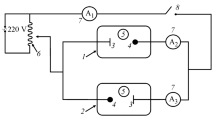Abstract
Using optical spectroscopy to study the metallurgical conditions in a cop-per converter, the critical end-point of the slag-blowing stage has been inves-tigated and a correlation established between the optical emission proper-ties of the converter flame and the Cu content of the white metal. Several practical implications for enhanced control of the converter process were also identified.
Similar content being viewed by others
References
W. Wendt, M. Alden, B. Björkman, T. Lehner and W. Persson, “Process Control of the Copper Converter Process by Emission and Absorption Spectroscopic Measurements” (Paper presented at the 26th Annual Conference of Metallurgists, Winnipeg, Canada, August 23–26, 1987).
W. Wendt, M. Alden and W. Persson, “Application of Emission and Absorption Spectroscopy for Characterization of a Copper Converting Process” (Unpublished).
B. Björkman and G. Eriksson, “Quantitative Equilibrium Calculations on Conventional Copper Smelting and Con-verting,” Can. Metall. Q., 21 (1982), pp. 329–37.
B. Björkman, “An Assessment of Cu, Ni, and Zn Silicate Systems,” Scand. J. Metall., 15 (1986), pp. 191–98.
I. Barin and O. Knacke, Thermodynamical Properties of Inorganic Substances, Springer, Berlin and Verlag Stahleisen, Dusseldorf (1973), and I. Barin, O. Knacke and O. Kubaschewski, supplement (1977).
G. Eriksson, “Thermodynamic Studies of High Temperature Equilibria, XIII. SOLGASMLX a Computer Program for Calculation of Equilibrium Compositions in Multiphase Systems,” Chem. Scr., 8 (1975), pp. 100–03.
A. Yazawa, S. Nakazawa and Y. Takeda, Advances in Sulfide Smelting, H.Y. Sohn, D.B. George and A.D. Zunkel eds., TMS (1983), pp. 99–117.
E.A. Johnson, P.E. Sanker, L.L. Oden and J.B. See, “Copper Losses and Distribution of Impurity Elements Between Matte and Silica-saturated Iron Silicate Slags,” Rep. Invest-U.S., Bur. Mines (1982), RI8655,22.
T. Lehner and R. Lindgren, “Bold Converter for the Smelting and Treatment of Complex Copper and Lead Concen-trates,” Proceedings of the Reinhardt Schuhmann Intl. Symp., ed. D.R. Gaskell (Col. Springs, November 9-12, 1986).
Additional information
W. Wendt received his M.Sc. from the Lund Institute of Technology (LTH). He is currently a graduate student at the atomic physics division at LTH.
M. Ald;en received his Ph.D. from LTH. He is currently an assistant professor at the atomic physics division at LTH.
B. Björkman received his Ph.D. from the Umea University. He is currently senior research metallurgist at Boliden Metall AB.
T. Lehner received his M.Sc. from ETH in Zurich. He is currently chief metallurgist at Boliden Metall AB.
W. Persson received his Ph.D. from the Lund University. He is currently head of Physics Department at Lund University.
Rights and permissions
About this article
Cite this article
Wendt, W., Aldén, M., Björkman, B. et al. Controlling Copper Conversion via Optical Spectroscopy. JOM 39, 17 (1987). https://doi.org/10.1007/BF03258956
Published:
Issue Date:
DOI: https://doi.org/10.1007/BF03258956




